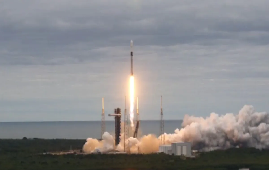Elon Musk owned SpaceX’s Falcon 9 successfully launched Indian Space Research Organisation’s GSAT-N2, a communication satellite. Both NSIL (NewSpace India Limited) and Elon Musk confirmed the deployment of the satellite into the orbit. NSIL wrote, “NSIL’s GSAT-N2 High-throughput (HTS) Communication satellite successfully launched from Cape Canaveral, USA on 19th November 2024.”
It further added, “GSAT-N2 weighing 4700 kg has been injected into the desired Geo-synchronous Transfer Orbit (GTO) and ISRO’s Master Control Facility (MCF) has taken control of the satellite. Preliminary data indicates satellite in good health.”
Collaboration With SpaceX
NSIL on January had announced the collaboration with Elon Musk’s SpaceX. This marked the first ever collaboration between two agencies. The collaboration was initiated as GSAT-N2 was too heavy for an Indian Launch Vehicle to carry it into space.
What Is GSAT-N2?
Geosynchronous Satellite, GSAT-N2 (GSAT-20) is a Ka-band high throughout communication satellite of NewSpace India Limited (NSIL).
NSIL is a company of Indian government under the Department of Space and the commercial arm of ISRO. GSAT-N2 is the 2nd Demand Driven satellite of NSIL.
This satellite will boost broadband services and in-flight connectivity (IFC) across the Indian region.
This satellite, features multiple spot beams and wideband Ka x Ka transponders, aimed to support a large subscriber base with small user terminals. It has a mission life of 14 years.
Equipped with 32 user beams, GSAT-N2 comprises 8 narrow spot beams over the Northeast region and 24 wide spot beams over the rest of India. These 32 beams will be supported by hub stations located within mainland India. The Ka-Band HTS communication payload provides a throughput of approximately 48 Gbps.
The agency said, “GSAT-N2 with 48 Gbps throughput capacity over India including A&N and Lakshadweep islands would cater to Broadband and IFMC service needs of the country.”



